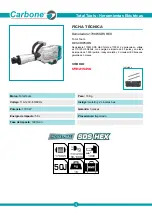
10
SECTION 4
P1350 AC POWER SUPPLY OPERATING CONSIDERATIONS
OPERATIONAL CONSIDERATIONS
4.1
OPERATION INTO LINEAR LOADS
The model P1350 will provide the best overall performance into a linear load. A linear load is
characterized by that fact that its current wave shape is sinusoidal. The phase relationship between the
voltage and current may be anything between zero and 90 degrees (leading or lagging). Some
examples of linear loads are as follows:
Most AC Motors, Power Transformers, Heating Elements, Resistors, Capacitors, Most Inductors
Incandescent Lighting ( without dimmers ), and Most Solenoids
Operation into these types of loads usually causes little interaction with the output stage of the model
P1350. The main concern with a linear load is the “inrush” current associated with it. Most heating
elements and resistors have no in rush concerns and usually do not present any problem for the power
source. Inductive and capacitive loads may present a special problem based on their construction and
the way in which they are energized. Motors and tungsten filament lamps also present some special
“start-up” concerns. The following is intended to give the end user some insight into applying the AC
source to these types of loads.
4.2
DRIVING REACTIVE LOADS
Capacitors and inductors are reactive in nature. If the load is applied during the peak of the AC cycle
there may be a considerable inrush of current several magnitudes larger than the steady state current.
This current is only limited by any series resistance that may be present in the load circuit. Under the
right conditions, this could trip the overload protection circuits in the power source. Certain transformers
and solenoids (inductance) present the same problem.
Several methods can be used to prevent tripping the protection circuits in the power source. One
common method is to insert a limiting impedance in series with the load. This could be a fixed resistor
or NTC (negative temperature coefficient) thermistor. Also, zero crossing switching can be employed.
The most obvious way to prevent a high in rush current is to apply the load with the voltage set to zero
(or some low value) and energize the load slowly by turning up the voltage.
4.3
DRIVING LAMPS
Tungsten filament lamps, when cold, present a very low resistance. Once they are energized, their
resistance quickly climbs to its steady state value. This characteristic must be accounted for when
driving tungsten filament lamps. The same methods for driving reactive loads can be applied to
tungsten.
4.4
DRIVING MOTORS
Driving an AC motor presents a special problem. Most motors require a starting current that is several
times higher than the running current. This current may last for a few cycles to several seconds
depending on the construction and mechanical load on the motor. This current is sometimes referred
to as the motor’s “locked rotor” current. This current is not to be confused with the in rush current that
usually occurs over the course of one or two cycles of the AC waveform.
The model P1351's fold-back current limiting can be an advantage when starting motors. During the
starting period, the motor will attempt to draw excessive power from the power source. The fold-back
circuit will reduce the output voltage in order to maintain the maximum current for the range in use.






































